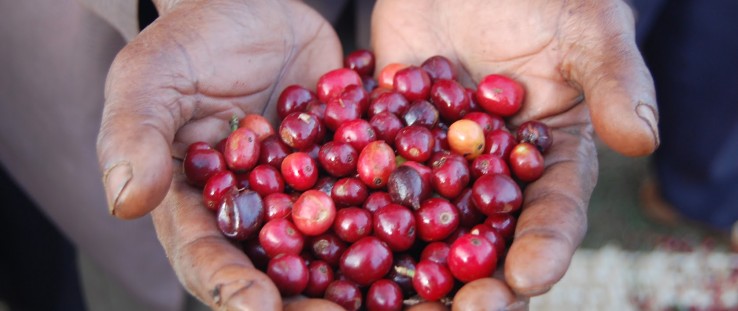 A worker at the Banko Gotiti Cooperative in the Southern Nations, Nationalities and People's Region of Ethiopia holds a handful of ripe red Yirgacheffe coffee berries.
Marcelo Pereira, USAID Agribusiness Market Development
A worker at the Banko Gotiti Cooperative in the Southern Nations, Nationalities and People's Region of Ethiopia holds a handful of ripe red Yirgacheffe coffee berries.
Marcelo Pereira, USAID Agribusiness Market Development
 A worker at the Banko Gotiti Cooperative in the Southern Nations, Nationalities and People's Region of Ethiopia holds a handful of ripe red Yirgacheffe coffee berries.
Marcelo Pereira, USAID Agribusiness Market Development
A worker at the Banko Gotiti Cooperative in the Southern Nations, Nationalities and People's Region of Ethiopia holds a handful of ripe red Yirgacheffe coffee berries.
Marcelo Pereira, USAID Agribusiness Market Development
With more than 500 billion cups consumed annually, coffee is the most popular beverage in the world. In the United States alone, an estimated 150 million people drink an average of 3.1 cups of coffee per day.
Even though the United States is the world’s largest buyer—accounting for almost 25 percent of global green (unroasted) coffee imports—Ethiopian coffee amounted to only 1 percent of U.S. imports in 2011 to 2012, and Ethiopian farmers produce less than 5 percent of the world’s supply of coffee.
Those are statistics Ethiopian coffee producers and USAID want to see go up significantly.
Between 2006 and 2011, USAID implemented a development program for the specialty coffee industry that provided technical assistance to more than 25,000 farmers; supported certification and specialization initiatives; and helped create new market linkages with international roasters. Sales for USAID-supported coffee clients nearly doubled from $22.9 million in 2006 to $41 million in 2011. Farmers in the USAID project increased their yields by 37 percent over the national average and the Agency helped certify nearly 28,000 hectares of coffee-production area, farmed by 12,000 smallholder farmers.
Today, USAID continues to strengthen the coffee industry through Agribusiness Market Development, its flagship project under the U.S. Government’s global hunger and food security initiative, Feed the Future, and its largest contribution to the Government of Ethiopia’s Agricultural Growth Program.
“Our vision for Ethiopia is to maximize commercial returns for unique, traceable coffees in export markets,” said Dennis Weller, USAID’s mission director in Ethiopia. “To achieve this, we are working to improve productivity and quality at the smallholder level, simplify the current coffee standards and grading system, expand traceability for importers, and raise the industry’s awareness of international market opportunities to secure higher prices in export markets.”
According to legend, in approximately 800 A.D., Kaldi, an Ethiopian goat herder, discovered coffee after noticing his goats dancing and playing after eating red berries in a grove of small bushes. He picked some of the berries to taste, but threw them into his fire because they were bitter. As they roasted, they gave off a wonderful smell, so Kaldi covered them with water to cool them and then drank the first brewed coffee in history. He shared the discovery with other monks and soon the word spread. Today, coffee is grown in many countries around the world, but its roots can be traced to the ancient coffee forests of Ethiopia.
Coffee Is Life
With more than 6,000 varieties of coffee to its name, Ethiopia is the largest coffee producer in Africa and the fifth largest in the world behind Brazil, Colombia, Vietnam and Indonesia. During the 2012-2013 growing season, the country’s rich volcanic soil and high elevation produced 8.1 million bags (60 kilograms each) of coffee. Nonetheless, Ethiopia is only the ninth largest exporter, partially because Ethiopians consume as much as they export. For Ethiopians, it is more than just a beverage to drink—it is a way of life. (See info box below.)
Coffee is also a major economic activity in Ethiopia and the country’s top export earner—accounting for $745 million in the 2012-2013 fiscal year. Smallholder farmers grow almost 90 percent of Ethiopia’s coffee on more than 500,000 hectares of land. In all, coffee sustains the livelihood of over 15 million people in Ethiopia.
So it seems counterintuitive that Ethiopia lacks a central entity to oversee activities in the coffee sector. This means too little collaboration and knowledge-sharing to improve production, processing and infrastructure. Limited knowledge and inattention to coffee quality damages the end product and leads to coffee being sold at lower prices, which negatively impacts everyone in the value chain, from grower to trader.
“While much of Ethiopian coffee trades at a discount in relation to international market prices, the country’s diverse coffee varieties have the potential to increase exports of quality coffees by more than 75 percent,” said Weller.
Increasing Income for Farmers
In spite of volume and strong coffee traditions, Ethiopian farmers have remained among the poorest in the world. To address this, USAID trains farmers on better harvesting, processing and storage methods to boost yields while improving product quality and marketability. These new methods should result in increased farmer incomes.
Alemu Abagero, one of 1,447 members of the Omo Beko primary cooperative in Oromia, received training through the USAID activity to improve the procedures he uses on his 2-hectare farm. Prior to the training, Abagero harvested all types of cherries—the ripe, overripe and unripe—then dried and sold them to the local market.
After the training, he selectively picked red cherries and sold about 2,000 kilograms for washed coffee processing to the primary cooperative, earning over $800, a 20 percent increase from what he earned before the training. He dried another 2,100 kilograms of red cherries on drying beds and stored the dry cherries in new burlap bags in a well-ventilated area to protect against mold and maintain quality. This will enable him to secure higher prices from domestic and international buyers.
“The advantage of selectively picking only the red cherries is that the plants will be healthier and provide sustainable production every year. Stripping all the cherries at harvest time damages the plants and requires a year to rehabilitate,” explained Abagero.
USAID also supports management and leadership training for farmer cooperative unions and primary cooperatives. Through training, the Choche Guda primary cooperative in Oromia prepared an operations plan and defined opportunities to increase income, such as receiving Fair Trade certification, which guarantees prices and links farmers with buyers, creating long-term sustainability for communities.
The training resulted in a 30 percent increase in membership to 969 members; the amount of coffee cherries purchased increased 138 percent over the previous year, reaching 517,500 kilograms. Choche Guda also created nine permanent jobs and hired more than 100 contractual and seasonal workers during the picking and processing season.
USAID provided funding to construct five coffee washing stations and mills as well. These are expected to produce 100 metric tons of coffee per year at each station and increase the price for coffee by more than $1.25 per kilogram on average in the international market. For Omo Beko members, this will result in a boost to income to $105 for each smallholder farmer household annually. In addition, each new station is expected to generate 18 permanent and 150 temporary jobs, of which 80 percent are estimated to be filled by women.
Investment in Crop to Cup
In June 2013, members of the East Coast Impact Angel Network (EIAN) traveled to the mountainous area of Hambela, deep in the heart of one of Ethiopia’s most famous coffee regions. The investors agreed to invest in METAD, an Ethiopian specialty coffee company. USAID facilitated the investment by conducting initial due diligence, presenting METAD to the investors, and leveraging additional financing to maximize impact to the local smallholder farmers and position METAD for commercial production.
“We all experience coffee from the consumer end, so this investment in Ethiopian specialty coffee has natural appeal to me,” said Dr. Andrew Umhau, one of the EIAN members who visited Ethiopia in June 2013. “I had the opportunity to experience the entire coffee supply chain firsthand in Ethiopia—from coffee bush to macchiato. The METAD management team understands coffee in Ethiopia, so we have great confidence in this venture.”
Following its initial $200,000 investment, the EIAN expects to invest more into the venture.
METAD will use the investment to establish a coffee processing facility on its coffee farm located near Yirgacheffe in the Oromia region of Ethiopia. The company expects to train more than 750 local farmers who will benefit by increased earnings resulting from a higher premium paid, up to 25 to 55 cents per kilogram, for better quality coffee.
“We are grateful for the support from USAID and the EIAN, and we are eager to use this investment to continue building Ethiopia’s reputation in the specialty coffee market,” said METAD CEO Aman Adinew.
The United States is the largest market for specialty coffee in the world, accounting for 55 percent of the $46 billion U.S. coffee market. Specialty coffee refers primarily to high-quality coffees, including those certified as organic, Fair Trade and Rainforest Alliance. Currently, 20 percent of Ethiopia’s coffee is exported as specialty coffee.
In May 2013, the Ethiopian Commodities Exchange (ECX) coffee laboratory became the first in Africa to meet the rigorous quality standards of the Specialty Coffee Association of America (SCAA). The recognition will further enhance Ethiopia’s standing in the international coffee market and increase the value of its coffees and the confidence of importers in the United States.
Certified labs provide consistent testing, grading and objective evaluation of coffee. USAID helped the ECX secure certification for the ECX central lab, and provided technical expertise, improved equipment and accredited cuppers training at three additional labs.
“As the birthplace of coffee, it is fitting that the first SCAA lab to be certified in Africa is in Ethiopia, and we are particularly proud that it is the ECX central lab that achieves this great milestone,” said Anteneh Assefa, former ECX CEO. “We would like to acknowledge the critical support of USAID and the Coffee Quality Institute in this ongoing endeavor. Our next focus will be on ECX’s eight regional labs to further strengthen our position as Africa’s leader in quality coffee.”
By 2013, the efforts of USAID to strengthen Ethiopia’s coffee sector attracted what is probably the single best known name for high-end coffee in the United States—Starbucks. The Seattle-based coffee behemoth introduced a new single-origin coffee from Ethiopia in September of that year. This new coffee joined Starbucks’ selection of 20 core and 10 traditional and seasonal whole bean coffees offered at its retail stores nationwide.
Much work was done behind the scenes prior to the Starbucks launch. USAID worked directly with several major farmers’ cooperative unions in Ethiopia to strengthen their ability to access the international market, improve their access to financing and acquire equipment. These cooperatives now sell directly to Starbucks. In addition, USAID is working with the ECX to build a traceability system that will allow Starbucks to identify the source of coffee.
“We’ve taken great care in sourcing this coffee and applying the signature Starbucks roast to create a flavor profile that is both uniquely Starbucks and unique to specialty coffee,” said Craig Russell, senior vice president of global coffee at Starbucks. “We want to honor Ethiopia’s rich coffee heritage while also giving our customers an exceptional flavor experience from the birthplace of coffee.”
“We continue to support many of the changes underway to significantly improve production, exports and traceability of Ethiopia’s quality coffees,” said U.S. Deputy Chief of Mission to Ethiopia Peter Vrooman at the 3rd International Ethiopian Coffee Conference in November 2014. “The United States will continue to be a committed partner in the development of Ethiopia’s coffee trade and its legion of smallholder growers.”







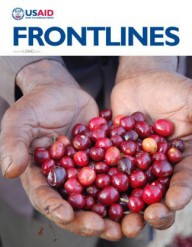

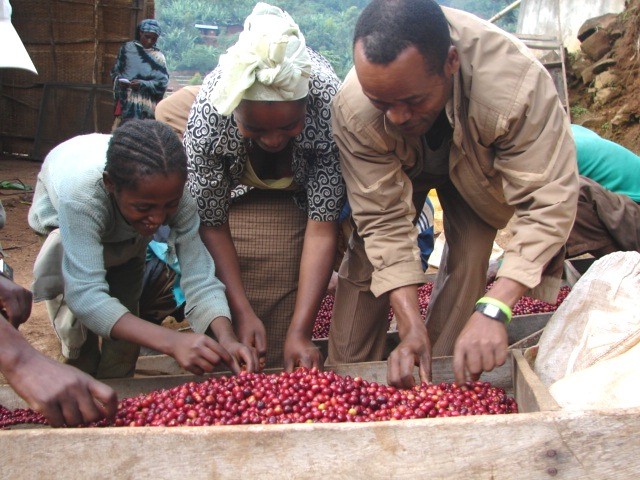
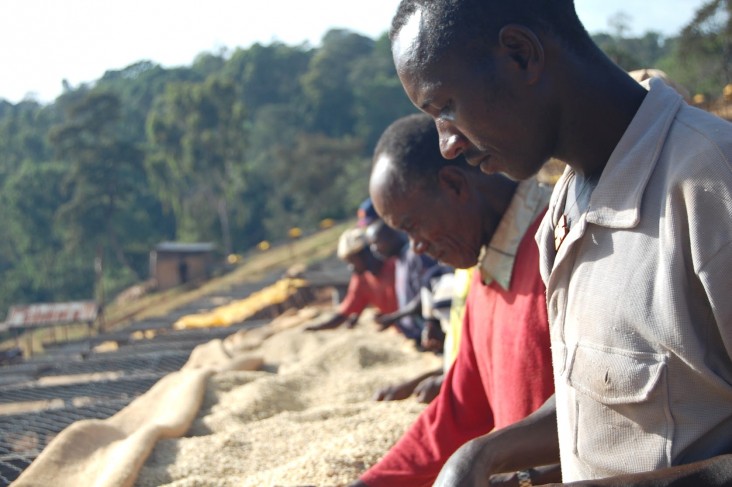
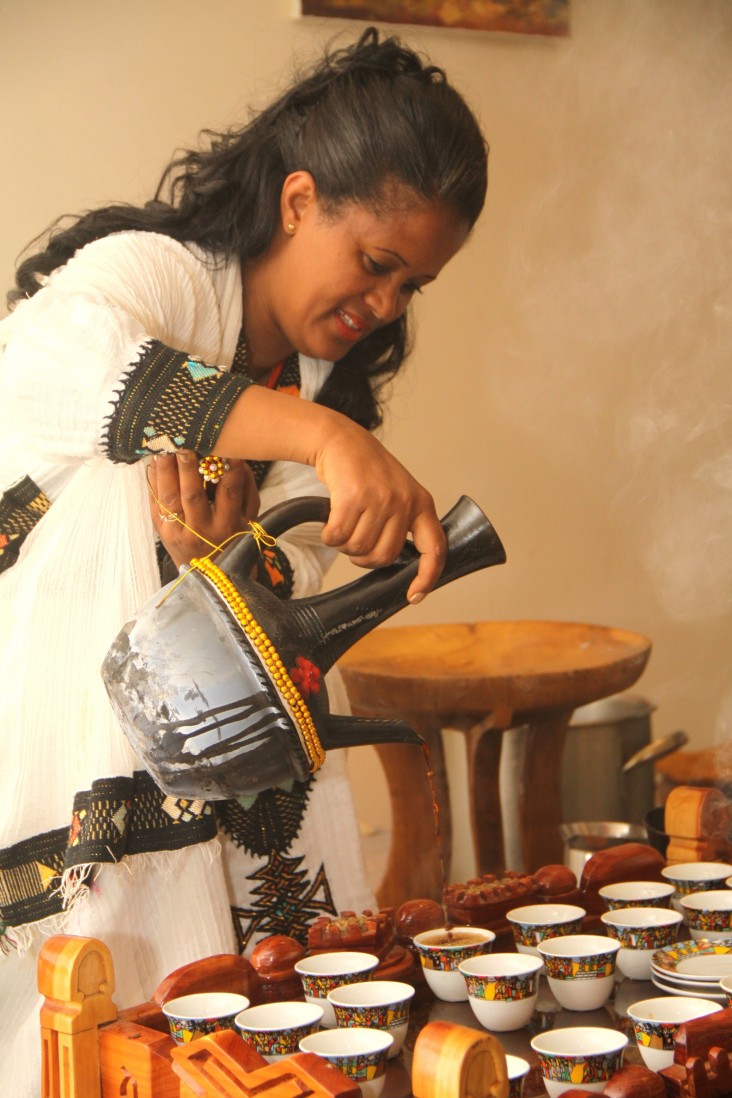
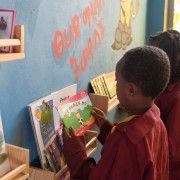
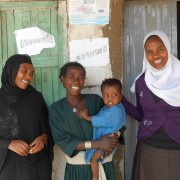
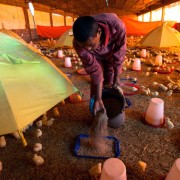
Comment
Make a general inquiry or suggest an improvement.